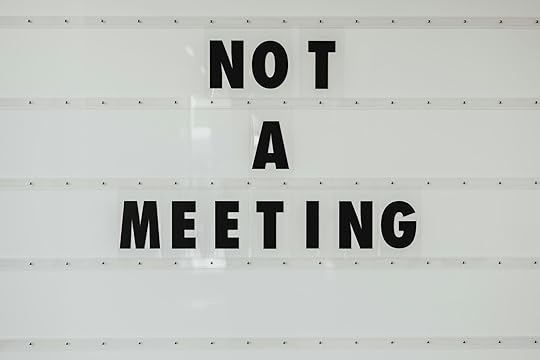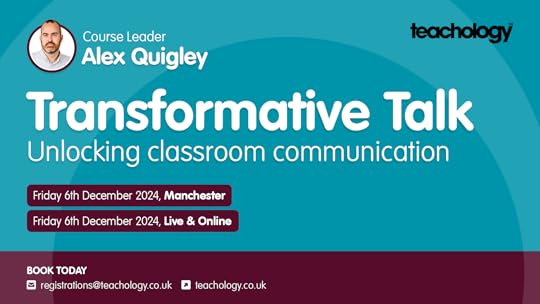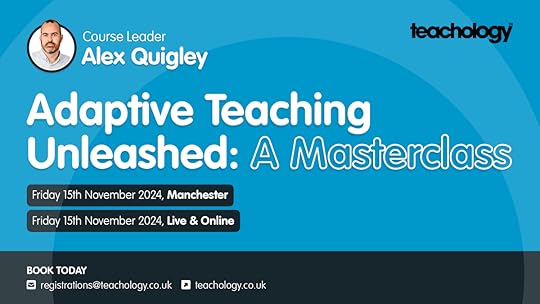Alex Quigley's Blog, page 6
November 9, 2024
Teacher development: what, why, and how

Every teacher can be sure of cyclical change. Governments come and go and the national curriculum and assessment shifts along with them. Teacher professional development trends come and go too.
We are left asking: what trends for teacher professional development will emerge?
Whether forms like instructional coaching will last the course, or professional learning communities come back in vogue, we need to ensure that they encompass the complexities of the ‘what', ‘why’ and ‘how’ teaching and learning happens.
Learning from past cycles of change – and sometime improvement – is valuable. In my twenty years involved in education, I think Graham Nuthall best captures the biggest crack in the edifice of teacher professional development and training:
“In most cases, there is a description of what to do and how to do it, but no description of why it might work. There is no explanation of the underlying learning principles on which the method or resources have been constructed. The result is teachers are constantly being encouraged to try out new ideas or methods without understanding how they might be affecting students learning.”
Graham Nutthall, ‘The Hidden Lives of Learners’
For example, it is easy to undertake instructional coaching about a specific teaching action – the how – and not really engage with understanding the why of deploying the strategy. The capacity to intelligently adapt a teaching approach is reliant on an expert understanding of the how, but also a vital grasp of the why.
Of course, teachers are time poor. School leaders understandable create professional development forms that try to maximise a shift in practice, so getting straight to the how is a pragmatic move. If it feels on an attractive poster, all the better. And yet, this pragmatic choice to focus on the how can quickly be compromised without a rich understanding of the why.
Why might this this teaching strategy work be likely to succeed in a given context? Why might it fail? Why might it work in one subject discipline but not another?
Though we often don’t like to admit it in shiny, 'the-next-big-thing' CPD sessions, most new strategies fail, at least at first, and teachers struggle to shift their practice and habits. At least if we understand why a strategy may be effective – such as the ever popular practice of ‘retrieval practice’ – we can better navigate when it goes wrong!
This is not an indirect critique of approaches like instructional coaching, that focus more squarely on the how. You can easily get wrapped up in exploring theory that doesn’t change anything. Merely musing over the why of teaching and learning is no better than singularly focusing on a flimsy formula for teaching practices.
There needs to be a judicious balance of why, what, and how in teacher professional development approaches. If we get the balance right, then we may make teaching more ‘intellectually attractive’, help improve teachers and better retain them in the profession too.
A worked example: working memoryProfessor Dan Willingham suggests we should have a ‘mental model of the learner’ to help train new teachers. Principles from cognitive psychology, like better understanding memory, can offer some of the why that informs how and what we teach.
I am convinced that understanding the limits of working memory is one of the most useful theories for teachers to understand. If pupils’ learning is always compromised by their ability to remember only small chunks of new information, it poses obvious implications for how we teach.
An understanding of working memory can inform curriculum design and sequencing, teacher explanations, modelling, scaffolding, chunking down complex tasks, and more. It can better inform key skills, such as developing pupils as successful writers.
Coaching a teacher how to live model writing on the whiteboard is unlikely to be deployed with consistent successful without a rich mental model of why working memory impacts on pupils’ thinking and their writing.
In Nuthall’s memorable description, “it’s like being told how to drive a car without being given any understanding of how the car and its engine work.” When the proverbial car breaks down, and our teaching attempts fail, teachers are left to fumble around with little clue what to do.
Whatever the trajectory of the next trend for teacher professional development, we need to ensure we balance the why, the what and the how, and not fall for the excitement of the shiny 'next-big-thing' approach.
Related reading: One of the big advances in teacher professional development is the EEF guidance report. Its forces on PD 'mechanisms', and a 'balanced approach', is a helpful support to get PD right - READ HERE . A related teacher development and training issue is grappling with the endless challenge of curriculum – see ‘Curriculum development is teacher development’ – READ HERE .This coming Monday - 12th Nov - I am doing a FREE Teachology twilight on 'Closing the Knowledge Gap' - SIGN UP HERE.

November 3, 2024
The 3Rs - - Reading, writing, and research to be interested in #50
November 2, 2024
Do we need to learn how to listen?

We are in an age of communication. We are connected more than ever before: with the ability to talk to friends and family across the world in an instant. You can publish your unfettered views on X, you can talk about and share your best life on Instagram, or create 30 second videos about nothing much important, all in an instant.
When we think of communication, we promote and prioritise talk. We celebrate speeches. We train pupils to debate and discuss. Talk and instant communication may be easier than ever… but what about prioritising learning how to listen?
In our age of mass, never-ending communication, listening may just be the lost art that we need, in the classroom and beyond.
Teaching listeningWhen I started teaching, many moons ago, I didn’t give a second thought to teaching pupils how to listen. It felt like the most natural thing it the world. It is just what you do when you are attempting to learn. Right?
Of course, very quickly I recognised that pupils needed training in ‘active listening’ – not just developing their ability to talk. The seemingly natural behaviour of listening for information, responding to peers, along with the little non-verbal responses to encourage listening and fruitful talk, all needed to be modelled and promoted in the classroom.
Students are expected to listen in the classroom and in the university lecture hall, as well as digest presentations in the workplace, or podcasts on their way home. If we teach effective listening with explicitness, we may maximise learning in marginal but significant ways.
Consider just some of the following strategies that relate to listening successfully:
Following arguments, noticing ideas, and noting the use of evidence or apt examples. Noticing non-verbal cues, such as gestures or facial expressions. Using context clues to understand unfamiliar words or ideas. Making inferences and posing questions about the content.Paraphrasing and summarising key information in your own words.Making effective notes whilst listening.In one area of the school curriculum, it is routine to teach and assess listening to others: that is in modern foreign languages. Around the world, tests for learning a second language including listening comprehension components, but it is not deemed necessary or useful for other areas of the school curriculum.
As a result of not paying attention to listening, in many curriculum areas you may have students giving presentations or debating, but their peers are passive and not listening actively. It is likely why Doug Lemov's concept of 'Ratio' has proven so popular - as it puts the emphasis on all pupils' maximising their mental efforts.
There are lots of existing strategies that teachers can draw upon that more effectively help children learn how to listen, whilst also promoting a culture of listening, participation and collaboration. Just some include:
ABC feedback. When discussing and debating in the classroom, listening to one another can be prompted by the ABC model. A stands for ‘Agree with’, B for ‘Build upon’ and C for Challenge. This simple scaffold helps eliminate the ‘dunno’ get out clause, whilst promoting more careful listening to one another. Cold Calling (or ‘no hands up’). This popular TLaC strategy is a mode of questioning that promotes more listening, and pupils need to attend to the teacher with close attention. The people behind TLaC have also shared the ‘Batched Cold Call’ approach, whereby pupils’ are set up to respond (e.g., ‘Once I’ve finished explaining the approach, I’ll ask Adil, Katie and Tom to respond first’). The key is intentional questioning that promotes focused listening. [Interestingly, Tom Sherrington calls 'Cold Calling the No.1 Strategy for Inclusive Classrooms', whereas Claudia Lewis poses a useful challenge - 'We need to stop cold calling']Structured note-taking. There are lots of ways to make structured notes, from the Outline Method , the Four Quarter Method , or the Cornell Notes Method . The key principle – no matter the format – is that pupils have a scaffold to organise their writing so that they can listen intently with a clear, supporting model to shape their record into writing. I am of the belief that teaching pupils how to make efficient, structured written notes could prove one of the most valuable ways to maximise learning available to teachers.Question generation. One way to more meaningfully process and comprehend when you are listening is to generate questions. As usual, pupils benefit from a scaffolded approach. Pupils may generate clarification questions (e.g. What is meant by the term XXXX?), cause and effect questions (e.g. what is the relationship between X and Y?) or evaluation questions (e.g. is the most important point that XXX?’)Promoting the importance of listening is nothing new. Just over one hundred years ago, in the government’s Newbolt Report (1921), they recommended, “children should be practised, not only in the art of speaking and reading, but also in the art of listening”.
Now, more than ever, active and precise listening strategies may be crucial to teach explicitly and to learn successfully.
I am delivering a NEW Teachology one-day masterclass on 'Transformative Talk: Unlocking Classroom Communication'. The training explores the issues that attend language development and best fostering structured talk in the classroom. It shares the best evidence on talk, speaking, listening, and more. Like my other popular literacy masterclasses, it is live and online, with exclusive resources including a guide to transformative talk, PPT slides, and more. FIND OUT MORE HERE.

October 26, 2024
Disciplinary literacy: 50 years of failure

Every maths teacher recognises the language of their subject is unique. Each teacher of history recognises that they teach pupils reading and writing moves that are different to maths teachers. Primary school teachers must teach the shifting language of subjects and topics from different corners of the curriculum on a daily basis.
This habitual approach to teaching the unique ways of knowing and communicating in a subject – and, crucially, the differences between subject disciplines – can be captured under the umbrella term, ‘disciplinary literacy’.
This is nothing wholly new to teachers of course. The 2014 National curriculum states that teachers should pay attention to “develop pupils’ spoken language, reading, writing, and vocabulary as integral aspects of the teaching of every subject”.
In fact, the issues of helping pupils access the tricky language of different academic disciplines is much longer in the tooth. Back in 1975, The Bullock Report stated:
‘We strongly recommend that whatever the means chosen to implement it, a policy for language across the curriculum should be adopted by every secondary school. We are convinced that the benefits would be out of all proportion to the effort it would demand, considerable though this would undoubtedly be.’
The Bullock Report (1975)
And yet, though we have made progress on many fronts with teaching, I don’t think we could claim we have cracked disciplinary literacy. There are few policies for ‘language across the curriculum’, nor sustained practices that ensures teachers can best support struggling readers and writers.
The recent report by the 'Oracy Commission' states that, "Teachers of these subjects, attentive to their subject’s purposes, explain things, provide resources and set tasks which foster practice in the subject’s discourse, whether that is correct use of a disciplinary vocabulary, encounter with a rich subject- specific text...". Whether it is primary or secondary, in maths or geography, disciplinary literacy plays out in reading, writing, vocabulary, and talk.
Year after year, pupils advance through their schooling, but the increasing complexity of reading, writing, vocabulary, and talk, continues to catch out far too many.
Why 50 years of disciplinary literacy failure?Why has disciplinary literacy not proven consistently successful in schools for over 50 years? We can anticipate some common barriers have beset attempts to teach the tricky language of subjects with sustained success.
1. Too little time
A lack of time – for teacher planning, curriculum design, and for teacher development – is a likely culprit. Without teacher development, curriculum development is compromised. Without curriculum being twinned with teaching strategies that address the complexities of academic language, we routinely drop disciplinary literacy as some extraneous extra.
2. Complex teacher training on language development and language barriers
There is a difficult challenge to support every teacher to understand how to best teach reading approaches, writing strategies, learn vocabulary, and to talk productively. They are at once everything we need to do, made harder by pupils having varied starting points and problematic literacy barriers (such as weak reading skills or handwriting issues).
National professional qualifications about leading literacy may be a help, but there is still a big jump to translate the literacy differences across a range of subject disciplines. This requires subject expertise, subject specific tools, and more.
3. An ever-changing curriculum
Various curriculum updates over the last 50 years have paid too little heed to the difficulty of mediating the complex reading, writing, and talk moves undertaken in the different disciplines. For instance, in the last curriculum update at GCSE, the attempt to make English literature more – well, English, and hard – has meant that even the GCSEs taught with language at their heart, have proven beyond the reach of many pupils.
We focus on the ‘what’ of curriculum, invariably stuffing in more and more content, but the ‘how’ of disciplinary literacy, and communicating through subject disciplines, can sometimes get too little attention.
4. Different things to teachers in different phases
One key issue to recognise is that disciplinary literacy becomes increasingly relevant – integral even – in secondary school. For primary school teachers, particularly at KS2, it is still relevant, but it is less integral. When children are still learning to read, then ‘reading like a scientist’ feels something quite distant as a goal.
Understanding the roots of disciplinary literacy, and how to grow it at each key stage requires a yet more sensitive knowledge and understanding, with intelligent adaptation. The time and support to do this is lacking. Bridges at transition need to be built.
5. What is it anyway?
One issue we cannot overlook that may account for 50 years of failure, is a lack of clarity about what disciplinary literacy is for subject teachers. Is it a glossy new label, or an explainer of simply how to teach? When you recognise the potential fuzziness of the thing – along with a dearth of available resources for a range of teachers and subjects – it makes sense that disciplinary literacy hasn’t cut through to enough teachers in enough schools.
The reality of 50 years of failure should give us pause.
Is it any surprise that time-poor literacy coordinators have made little ground with disciplinary literacy across the years? The reality is that subject teachers, middle leaders, and curriculum developers, need to lead the disciplinary literacy charge. They require more time, more sustained support and training, to do this challenging job. You cannot merely inspect it without the means to improve it.
As the Bullock Report stated over 50 years ago, if we were to get disciplinary literacy right, for a huge number of pupils, the benefits would be out of all proportion to the collective effort it would demand.
The solutions to the challenge don't fit into this blog, but the EEF guidance on for 'Improving Literacy in Secondary School' is an excellent start.

The EEF Literacy Content and Engagement Specialist, Chloe Butlin, has also developed these helpful resources on the 'Disciplinary Literacy Tree'.
There is also a wealth of expert practitioners tackling the challenge - see here for more:
' How to develop disciplinary literacy in maths ', by Elizabeth Bridgett.' Exploring disciplinary literacy in science ', by George Duoblys. ' What is disciplinary literacy and how can we embed it? ' by Johnny Richards. ' Exploring disciplinary literacy in maths ', by Amarbeer Singh Gill. ' Disciplinary literacy: Reading in subject disciplines ', by Mark Miller.' Using dialogue to secure scientific understanding ', by Kate Walter. ' How I teach extended writing in science ', by Dr. Jo Castelino. ' Improving primary science: Developing pupils' scientific vocabulary ', by Jody Chan.October 19, 2024
The 3Rs - Reading, writing, and research to be interested in #49
October 12, 2024
Adaptive teaching and the power of anticipation

Teaching is brilliantly complex, endlessly challenging, and potentially the most rewarding of the professions. No two lessons are the same. No two classes are the same. This diversity and complexity demands an expertise from teachers that is too often underestimated. Teachers need to constantly anticipate, act and adapt.
There is a recognition the classes are increasingly diverse. For example, around 1 in 5 pupils in English schools have identified special educational needs. It is no surprise then that ‘adaptive teaching’ has proven popular, as it offers practical ways to address the reality that all pupils are learning in different ways, at different rates, while many are struggling to learn.
Adaptive teaching describes the deft expertise of being responsive to the in-the-moment realities of all teaching. It comes into play when the lesson plan goes off-piste because pupils know less than expected about atomic structure in GCSE science, or when young children hold a crucial misconception about place value in maths.
While we rightly conceive of adaptive teaching as commonly occurring during tricky tasks and in the middle of busy lessons, expert teachers can make vital planning steps to anticipate for adaptive responses before they teach too.
Planning that unlocks the power of anticipation
A teacher who is an ‘adaptive expert’ routinely anticipates skilfully before they adapt responsively.
What practical examples of powerful anticipation align well with adaptive teaching?
Teachers typically seek out issues that prove barriers to learning, such as:
Key gaps in prior knowledge, such as possessing a weak chronology when learning about the Tudors in history.
Common misconceptions, such as a skewed sense of scale and space when learning about the atom.
Simplistic stereotypes, such as attitude to gender when learning about Lady Macbeth in English literature.
Limited working memory, such as when primary teachers are teaching how to draft, edit and revise their recount writing.
Literacy challenges, such as fluency issues when reading aloud, or handwriting issues.
Self-regulation challenges, such as the typical struggle to execute independent reading successfully.
It’s clear that anticipating where learning will be likely to break down for the pupils is one of the key prerequisites for successful adaptative teaching (and there just so happens to be an excellent book about ‘Why Learning Fails’ too!).
Experts who anticipate
One of the key academic experts on teacher expertise, Prof David Berliner, described expert teachers as having, “more accurate pattern recognition capabilities”. They better anticipate. Not only that, but they also “are more flexible, are more opportunistic planners”, compared to novices that are “more rigid in their conceptions”. He could be describing adaptive teaching.
Anticipation comes from teacher expertise, but expertise requires ample experience. There is no shortcut to acquiring the depth of knowledge and experience required for effective anticipation, but deploying teaching strategies that quickly offer diagnostic assessments of pupils’ learning can accelerate the process.
The following strategies can help teachers quickly anticipate learning barriers, so that teachers can adapt:
Pre-testing. Perhaps paradoxically, testing pupils on a topic before they have studied it can help reveal gaps in their knowledge, but also prime them for future learning. This approach needs to be treated sensitively, but done well it can develop curiosity and increase motivation to learn. Anticipation guides. A set of statements or questions about the key concepts of the new content that students answer before learning the material e.g. in science, posing true or false statements, such as ‘Plants get their food from the soil’, can initiate discussion and quickly tease out misconceptions.Mini-whiteboard checks for understanding. Many teachers swear by the good ol’ mini-whiteboard. In subjects like science, where recall of facts or quick visuals of models can be quickly represented on the whiteboard, it proves a longstanding strategy to foster anticipation and fuel adaptive teaching (see a handy blog by Adam Boxer HERE). Diagnostic questions. Multiple choice questions can pose targeted questions, where carefully selected ‘distractors’ can help identify common misconceptions (Dylan Wiliam promotes them as ‘hinge-point questions’). For example, pupils learning about cyclones in geography could be posed this‘Which of the following statements about cyclones is correct?
A) Cyclones are formed when cold air masses move rapidly towards the Earth's surface.
B) Cyclones rotate clockwise in the Northern Hemisphere and counterclockwise in the Southern Hemisphere due to the Coriolis effect.
C) Cyclones are caused by high-pressure systems and are characterized by clear skies and calm weather.
D) Cyclones form over warm ocean waters where the air is humid and rising, creating low-pressure systems and strong winds.’
Adaptive teaching has been coined – and proven popular – because it reflects an increasing range of needs being evident in the classroom in schools in England. But I think it also proves popular because it is sensitive to the type of anticipation, and expert decision-making, that teachers enjoy and respect. You cannot script it. You cannot buy posters which neatly capture it. But you can learn it.
The best teachers understand the power of adaptive teaching - and anticipation - and they put it to work to make a difference for their pupils.
Related reading:
‘Adaptive Teaching: What is it anyway?’ ‘Adaptive teaching and vocabulary instruction’ ‘Adaptive teaching: Scaffolds, Scale, Structure and Style’ ‘Adaptive teaching or reasonable adjustments?’For the last time of the year, I am teaming up with Teachology to do a live and online masterclass on 'Adaptive Teaching Unleashed'. I unpack the 3As of adaptive teaching, and much more (with an exclusive teacher guide and resources). It is sunny Manchester on Friday 15th November. READ MORE HERE.

October 5, 2024
The 3Rs - Reading, writing, and research to be interested in #48
October 4, 2024
Writing and the 'final mile' problem

Do your pupils have a problem with 'writing stamina'? The teachers and leaders I work with routinely describe the problem of pupils lacking writing stamina as a vital issue they want to address.
But what is writing stamina anyway? I find it is typically a catch-all for a range of common issues for novice writers. It most typically describes issues with the physical demands of handwriting, the running out of ideas half-way through a task, and the failing to edit and adequately revise and improve their writing. Most commonly, it is a messy collection of all these issues all at once!
Whether it is lots of notes on a science topic, an essay in history, or a substantial story writing task in English, many pupils are undertaking regular writing marathons. And they are struggling to muster the stamina to be up to the task.
By the time it gets to pupils having to edit and revise their writing, it is the tired ‘final mile’ of their writing. Is it any surprise this goes awry?
Fixing the final mile problem: moving editing and revising
A common observation for every teacher is that errors increase as pupils’ write more. Every additional five minutes of writing is likely to tax pupils’ previous mental energy and limited working memory capacity.
Effectively, we ask pupils to do think hard about making improvements when they have fewest mental resources to do the job.
A key solution to the final mile problem – and how to improve pupils’ editing and revising – take a paradigm shift in how we view writing. We need to change our thinking, and teaching, and have pupils edit and revising throughout their writing and not just at the end.
One of the key strategies to improve editing I promote is ‘Editing stops’. It is a simple notion. Just like a marathon runner taking a vital short water break, editing stops can be offered for concise and precise editing efforts. It also allows pupils the opportunity of a refreshing review point to consider revising their writing. Additionally, teachers can use the opportunity to home in on a specific aspect of their writing to edit, thereby not managing their stamina for making meaningful improvements.
Another approach that I see enacted well (particularly in primary school classrooms) are ‘Editing teams’. In the real world, authors and journalists have their peers to help them. Whether it is an editor, a copy editor, or helpful ‘readers’, most real authors writing individually, but call on teams to help.
With clear role and goals – such as pupils working in trios, each with a task to review their writing for a specific purpose – editing teams can eliminate the stamina-sapping reality of undertaking a writing marathon alone.
The ultimate aim for independent writing is that pupils themselves edit and revise their writing in a continuous, purposeful fashion. For our novice pupils, often struggling, it requires lots of explicit supports – such as planning scaffolds, editing guides, editing teams, editing stops, and more. Crucially, we will need to shift our support from just spending five or ten minutes at the end of a writing task.
Put simply, editing and revising needs to occur throughout any extended writing task, not just at the end.
Over time, with explicit instruction of editing and revising throughout the act of extended writing, pupils aren’t burdened with the daunting big editing and revision job in the final mile. Instead, they become confident, competent writers, who can run the final mile with the necessary stamina, and support, to succeed.
Related reading:
I have written three blogs on writing stamina, editing and revising in depth here:
See my blog on ‘The struggle with writing stamina’ - HERE . See my blog on ‘The challenge of editing writing’ - HERE . See my blog on 'Revising writing and why it matters' - HERE .If you now have the thirst for a marathon reading task to better tackle the teaching of writing, my book ‘Closing the Writing Gap’ – available at Routledge HERE and Amazon HERE.
September 28, 2024
Misreading dyslexia

Dyslexia is one of most common special needs that impacts learners in schools. It is an issue, and a label, that is well known, but probably less well understood. So, why are we misreading dyslexia and what can we do about it?
This crucial issue with reading words on the page accurately (along with related spelling issues) can prove hard to define. It is estimated that there are around 6 million people with dyslexia in the United Kingdom – around 10% of the population. However, we should be wary of such estimates, as they aren’t very accurate, and they are strongly contested too. Some researchers argue for something much lower, at around 4% (the likelihood of severe dyslexia is that is nearer the lower end of those estimates).
Of course, if we struggle to define these reading difficulties, then it is going to prove harder to diagnose and to support. New research from Durham University, entitled ‘Identifying students with dyslexia: exploration of current assessment methods’, how shown a worrying reality. A significant proportion of dyslexia professionals hold one or more misconceptions about dyslexia.
The research would indicate that we have too little shared basis of expertise for identifying dyslexia and even professional experts in the field fall for myths. Misconceptions like the false belief that children read letters in reverse (though there is some evidence the children can muddle up anagram words e.g., smile and slime; tried and tired) means that children may not be getting accurate diagnosis.
The evidence also showed a lot of variable use of dyslexia assessments. For example, some children didn’t meet the cut-off point, but contextual information could see the dyslexia label being issued regardless. Problematically, many well-meaning parents are shelling out a great deal of money to pay for such assessments.
Beyond dyslexia myths and misreadingsIf experts in the field can misread the dyslexia diagnosis, and its basis, then how are busy teachers and leaders meant to deal with this complex challenge?
When you dig into the research evidence attending how you support a child labelled with dyslexia, you also recognise more misconceptions and misreadings. The very popular coloured overlays that are commonly used as a reasonable adjustment have little consistent evidence of effectiveness beyond proving to be a mild placebo. Not only that, the legion of special dyslexic fonts , and other seeming technology aids, have little evidence of effectiveness either.
It is vital to support pupils with such reading difficulties as early as possible, so we need a better shared definition, widespread understanding, and we need to bust dyslexia myths.
School teachers, leaders – and parents – should push for the following:
An improved shared definition of dyslexia – along with its causes, symptoms, and best evidenced supports.
Better validated and regulated assessments, including greater support to access such assessments.
Sustained and updated accreditation for reading and dyslexia experts.
Career long training for teachers and school leaders on reading development, common reading issues, and dyslexia.
A determined national focus on early language intervention. If you don’t address reading difficulties early, it can compromise a child’s education.
Ultimately, we cannot accept a situation where a serious national issue, affecting so many children, has so many issues that go unaddressed.
Related reading: My book, 'Closing the Reading Gap' has a chapter on reading issues - find it HERE . I have written about practical approaches to 'Making the difference for dyslexic pupils' HERE . Research on ‘Forty Years of Reading Intervention Research for Elementary Students with or at Risk for Dyslexia: A Systematic Review and Meta-analysis’ Hall et al. (2022), gives a helpful overview of dyslexia issues and interventions.September 21, 2024
The 3Rs - Reading, writing, and research to be interested in #47
Alex Quigley's Blog
- Alex Quigley's profile
- 12 followers



